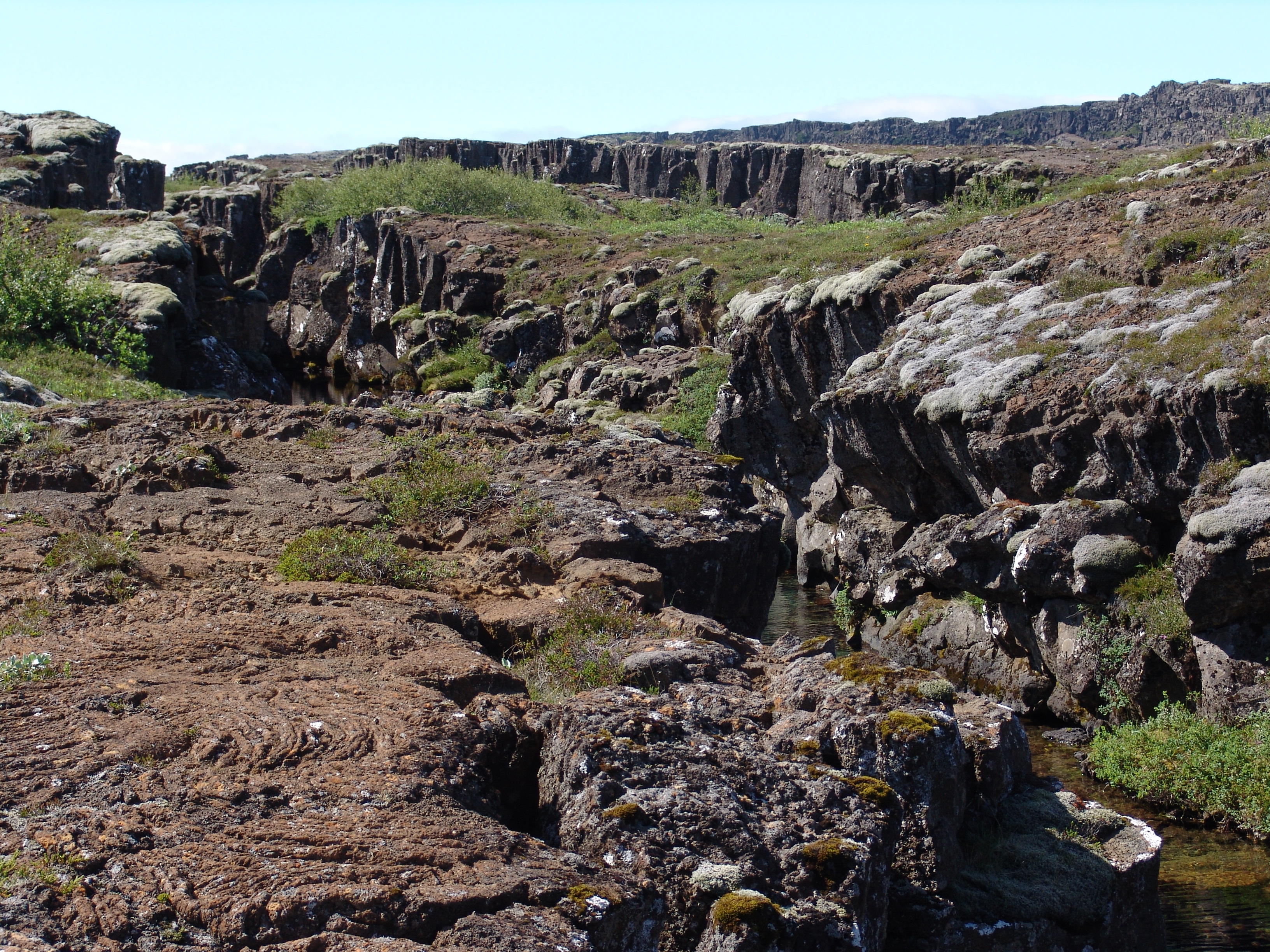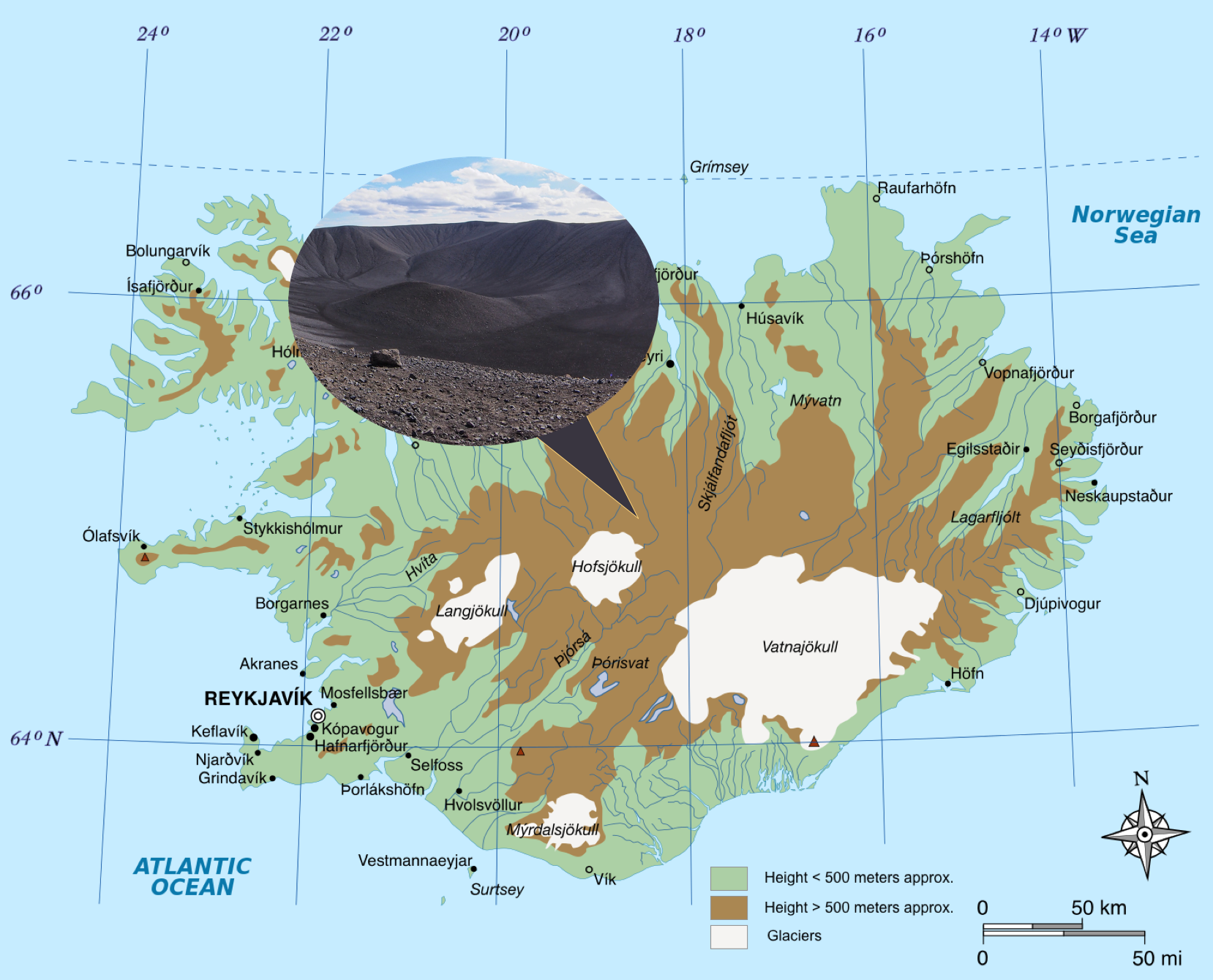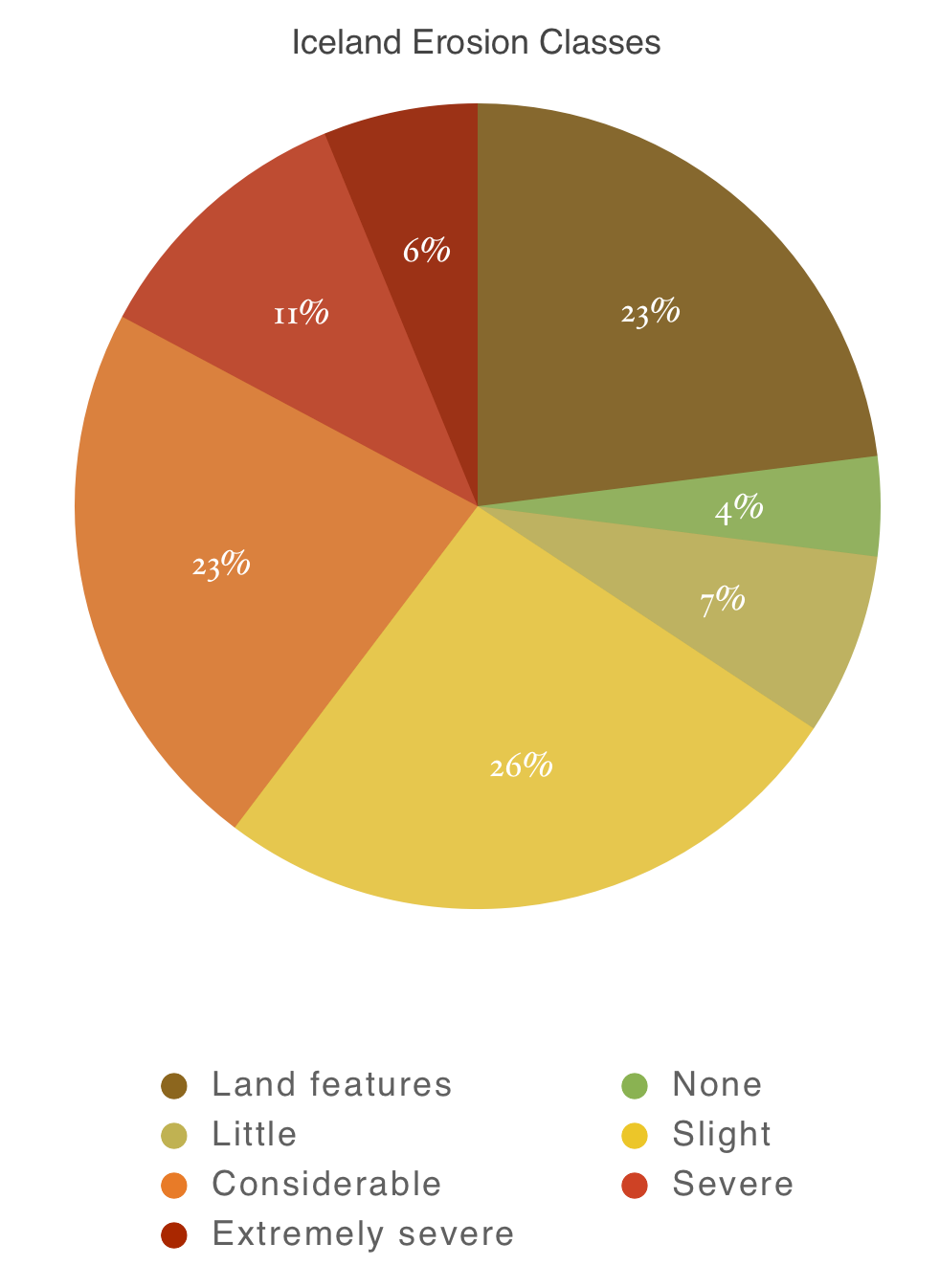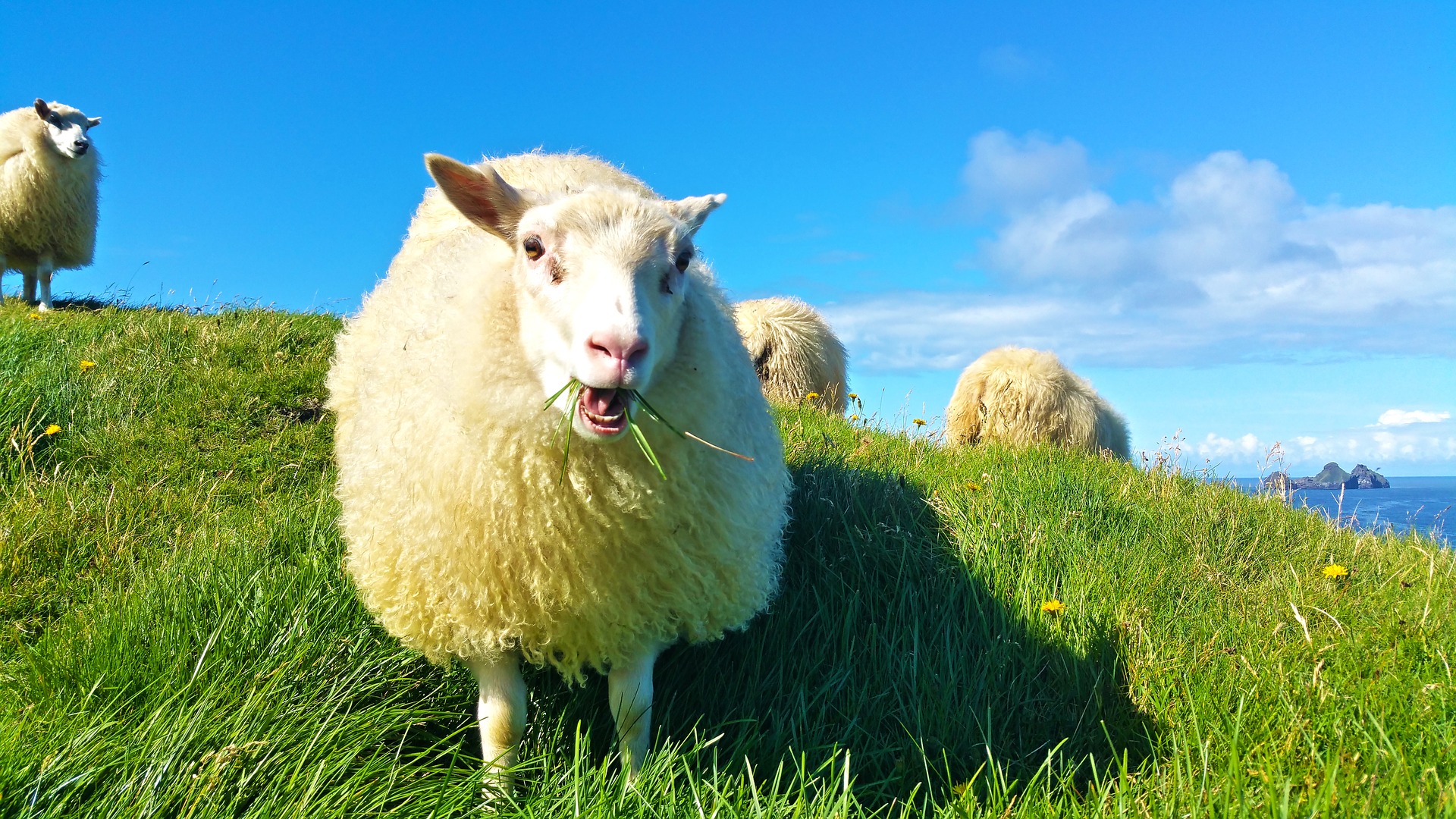Sustainability
5.2 Soil Erosion in Iceland: Reclaiming a Fragile Environment
Leslie M. Beauchamp
Centuries of human activity in a fragile volcanic environment is eroding soils and vegetation in Iceland. Various programs have been introduced to better regulate industries such as farming. Could something like afforestation reverse erosion effects as well as assist in lowering CO2 emissions?

The island nation of Iceland is characterized by high volcanic activity, cold winters, and cool summers due to the climate moderating effects of the Atlantic Gulf Stream.2,3 The landscape can be defined as sparsely vegetated, or having less than 50% of land surface covered by vegetation.1,11,13 There is also virtually no tree cover, though that is a historical change.1 Before human settlement, nearly 65% of the country was covered in vegetation.1 Since settlers arrived with livestock, about 50% of that vegetative cover has been lost due to harsh climates, volcanic activity, and wind, paired with human activity and livestock overgrazing.1,11 The exposure of the soils and consequent erosion has caused a disruption in the distribution of soil organic carbon as well as a loss of biodiversity.6,9,11,12
Iceland has a population of approximately 280,000, with the first settlers having arrived with their livestock approximately 1,100 years ago.1,2 With the introduction of herbivorous animals, the evolution of Iceland’s vegetation was altered, and the fragile volcanic soils quickly began to erode.1,10 These highly erodible Andosols, which are typical of the Icelandic Highlands, can be characterized by a large proportion of coarse-grained solid material, high porosity, low levels of organic matter, low cohesion, and the dispersal of many layers of tephra caused by frequent volcanic eruptions.3,4,8,9,10

Scientists used tephrochronological dating to determine the types of vegetation that were present on these lands before settlement, finding that the majority of areas now prone to desertification had been dominated by birch woodlands.1,7,8,12 The most dramatic decline in vegetation, and resulting soil erosion, was found to coincide much more directly with dates of human settlement than with climate change, with deforestation peaking in the 18th to 20th centuries.1,7,8,11 This information indicates that the rapid destruction of Icelandic soils has been primarily induced by anthropogenic factors. While overgrazing by sheep and horses is a more obvious contributor to this, common cultivation practices such as planting crops in rows can lead to excess runoff, furthering the progression of erosion.5
The effects of early land degradation caused by human activities can be seen in a variety of different areas. These effects include farmers being forced to relocate or abandon their farms due to shifting sand dunes, erosion of stream banks impacting aquatic species through habitat depletion, and a reduction in biodiversity leading to a decrease in natural carbon sequestration.6,8,10 In a study on the effects of soil erosion on soil organic carbon, it was found that atmospheric carbon (CO2) released over approximately 1000 years of soil disturbance is equivalent to that of up to 320 years of current anthropogenic emissions.9 A study conducted in 2000 found that due to recent afforestation efforts, Iceland’s C-sequestration totaled 4.7% up from 2.9% just five years earlier.11 In an interview with host Scott Simon on National Public Radio in 2007, Soil Scientist Dr. Olafur Arnalds and Assistant Director of the Icelandic Soil Conservation Service Dr. Andres Arnalds, discussed how afforestation is a necessary process for sequestering excess CO2 that has volatilized into the atmosphere following the erosion of carbon-rich soils.12 The researchers believe that Iceland has the potential to become a zero-emission country under proper management.12 Other scientists agree that the creation of forest plantations in soils with inadequate carbon levels could help reduce national greenhouse gas levels, assisting in overall goals to diminish factors contributing to climate change.11

So, why have the effects of land degradation not been a prevalent issue in other heavily grazed and farmed areas such as the Great Plains in the United States? This has to do with various geologic and climatic conditions in Iceland that are specific to this fragile ecosystem, some of which put the island nation in the ill-fated position of continuing on this degenerative path. Iceland is rampant with volcanic activity, with an eruption occurring at a historic rate of 20 per century.1 These eruptions, such as the destructive Eyjafjallajökull eruption in 2010, can cause large-scale dust storms that bury vegetation in Aeolian deposits.4 A loss of vegetation leaves top layers of soil without a steady root system, and thus is easily disrupted by wind erosion.4,10 Volcanic activity that occurs beneath Iceland’s large glaciers can also have profound effects on soil stability due to water erosion from severe flooding.1,3,4 These numerous specific environmental factors acting together in a systematic manner makes it difficult for land managers, governing bodies, and scientists to derive long-term solutions.
The Icelandic Soil Conservation Service was established in 1907 in response to the extent of land degradation issues.2 Various programs have been introduced in recent years to better regulate sustainable farming and grazing activities.2 In 2000, the government and sheep farmers came to a subsidy agreement provided that certain criteria was met by the farmers, such as no grazing in areas defined as highly erodible.2,5

Social scientists have asserted that human practices that compromise land quality should be put into a more synergistic context while seeking government regulation.6 In 2005, G. Gisladottir explained that there is a greater likelihood of government involvement and funding for conservation efforts if the underlying issues are described and understood to be an issue of poverty alleviation and food security.6 The suggestion that environmental issues are directly correlated with socioeconomic factors is a critical idea in the endeavor to determine a permanent resolution.5 This is a natural reaction considering that many recent environmental and climate change-related problems have been attributed to human action.
Afforestation remains a very promising method of reversing damage done by erosion. Research to discover more effective, long-lasting solutions towards Iceland’s largest environmental issue are ongoing, as well as initiatives to regulate harmful practices. The ability to connect every factor, both natural and social, while seeking answers for such a complex natural phenomenon will be crucial to gain a broad and complete understanding and take the first steps to restore this unique, fragile, and beautiful environment.
References:
- Arnalds, A. (1987). Ecosystem Disturbance in Iceland. Arctic and Alpine Research, 19(4): 508–513.
- Arnalds, O., & Barkarson, B. H. (2003). Soil erosion and land use policy in Iceland in relation to sheep grazing and government subsidies. Environmental Science & Policy, 6(1): 105–113.
- Arnalds, O. (2004). Volcanic Soils of Iceland. CATENA, 56(1–3):3–20.
- Arnalds, O., et al. (2013). An extreme wind erosion event of the fresh Eyjafjallajökull 2010 volcanic ash. Scientific Reports 3(1257):1-7.
- Boardman, J., et al. (2003). Socio-economic factors in soil erosion and conservation. Science & Policy, 6(1): 1–6.
- Gisladottir, G., & Stocking, M. (2005). Land Degradation Control and its Global Environmental Benefits. Land Degradation & Development, 16(2):99–112.
- Gísladóttir, G., et al. (2011). Soil evidence for historical human-induced land degradation in West Iceland. Applied Geochemistry, 26:S28–S31.
- McGovern, T. H., et al. (2007). Landscapes of Settlement in Northern Iceland: Historical Ecology of Human Impact and Climate Fluctuation on the Millennial Scale. American Anthropologist, 109(1): 27–51.
- Óskarsson, H., et al. (2004). Organic carbon in Icelandic Andosols: geographical variation and impact of erosion. CATENA, 56(1–3):225–238.
- Runólfsson, S. (1987). Land Reclamation in Iceland. Arctic and Alpine Research, 19(4): 514–517.
- Sigurdsson, B. D., & Snorrason, A. (2000). Carbon sequestration by afforestation and revegetation as a means of limiting net-CO2 emissions in Iceland. Biotechnologie, Agronomie, Société et Environnement, 4(4): 303–307.
- Simon, S. (Host). (2007, December 22). Iceland Seeks to Restore Soils, Forests [Radio broadcast episode]. Retrieved January 28, 2016, from http://www.npr.org/templates/story/story.php?storyId=17548004
- Vegetation types: Major vegetation types in Iceland. Icelandic Institute of Natural History.
Figures:
- Arnalds, O. et al., Soil Conservation Service, Agricultural Research Institute. (2001). Soil Erosion in Iceland. [Data for soil erosion graph].
- Huang, Chen. (2015). [Photograph of tephra crater in Hverfjall]. Modified from Panoramio. CC BY 3.0.
- Morgner, Manfred. (2005). [Photograph of soil degradation at Pingvellir, Iceland]. Retrieved from Wikimedia Commons. CC BY-SA 3.0.
- Pethrus. (2010). [Map of highlands of Iceland]. Modified from Wikimedia Commons. CC BY-SA 3.0.
- shaharkehat. (2016). [Photograph of sheep grazing]. Retrieved from Pixabay. Public Domain.
